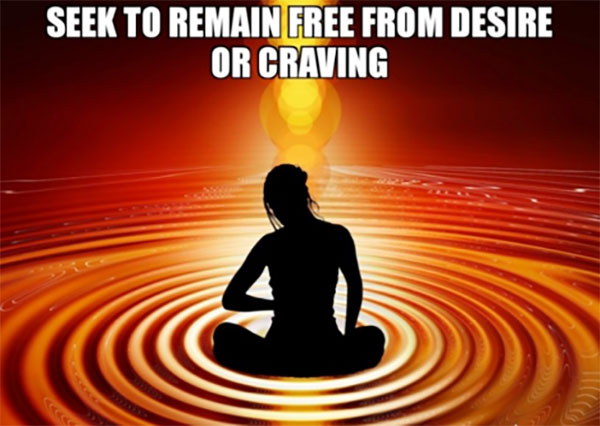Chapter 1 – Concentration/Samadhi Pada – Part 5
Practice & Non-Attachment, cont. – Yoga Sutras (1.15 thru 1.16)
These two sutras cover non-attachment and supreme non-attachment. While the principle applies to all the gross and subtle levels, a gross level example will help. A good example of this is two smokers …
Imagine two people who quit smoking many years ago. One is still attached to cigarettes, and when he sees a cigarette, the craving begins. When he resists acting on that desire, and then let’s go of the desire, this is the meaning of detachment (an act of avoidance).
The other person also used to smoke, but when he sees a cigarette there is literally no reaction; the desire has completely disappeared at all levels of his conscious and unconscious mind. This is the meaning of non-attachment. The attachment is not released but is simply not there anymore; it is the absence of attachment.
Yoga Sutra (1.15) – drista anushravika vishaya vitrishnasya vashikara sanjna vairagyam. Drista means seen or perceived. Anushravika means revealed, heard (from others). Vishaya is objects, subjects or entities. Vitrishnasya is of one who is free from desire or craving. Vashikara means supreme, mastery or total control. Sanjna means awareness, consciousness or knowing. Vairagyam is non-attachment, indifference, dispassion or neutrality.
Translated this means: When the mind loses desire even for objects seen or described in a tradition or in scriptures, it acquires a state of utter (vashikara) desirelessness that is called non-attachment (vairagya). In other words, dispassion (or non-attachment) results from a balance in (or mastery of) the consciousness, and when the desire for all things that we see or have heard of is extinguished.
This non-attachment is not suppression nor detachment as these are both pretentious and a case of “doing” something. This non-attachment is instead a “non-doing” sort of thing. It means that your attention does not hold (or grab onto) any impression that appears in the mind in the first place. Non-attachment is cessation! Sometimes attachment does occur (appealing or not) and attention fixes itself on a deep mental impression. In this case the subsequent non-attachment comes from the cessation of mental clinging, not from an act of forcefully prying attention away.
Patanjali further explains that non-attachment (vairagya) applies to progressively deepening levels of our being. We might begin with our shallower level attachments, such as the objects and people encountered in daily life. But this practice is intended to “deepen” to include all objects or experiences. Even those we might have only heard about, including the many powers (siddhis) or experiences of the psychic or subtle realm.
We gradually come to witness that even these are nothing more than distractions on our journey to Self-realization, and we learn to let them pass by as clouds in the sky.
Yoga Sutra (1.16) – tat param purusha khyateh guna vaitrshnyam. Tat is “that.” Param is higher, superior, supreme, transcendent. Purusha means pure consciousness, or Self. Khyateh means through knowledge, vision, discernment. Guna represents the elements, prime qualities, constituents or attributes (three gunas of sattvas, rajas and tamas). Vaitrshnyam is that state of freedom from desire or craving (for the gunas)
This sutra can be translated to mean: Indifference to the subtlest elements, constituent principles, or qualities themselves (gunas), achieved through a knowledge of the nature of pure consciousness (purusha), is called supreme non-attachment (paravairagya). In other words the highest state of desirelessness (unsurpassed non-attachment – paravairagya) arises from the experience of the true Self. In this state even the most basic elements of nature lose their power over us.
Supreme non-attachment (paravairagya) to the gunas,which are the three primal elements. That the yogis refer to these as the prime constituents of both manifest and unmanifest matter (prakriti). This includes non-attachment in relation to not only the gross physical world, but also to the entire subtle, psychic and astral planes, as well as the causal realm out of which they arise.
Paravairagya comes after Self-realization and is described in these sutras as where non-attachment ultimately leads. That is, once you have the tool of samadhi and direct experience of the higher Self.
~Rae Indigo
